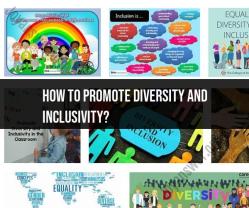How to conduct diversity training effectively?
Effective diversity training is an essential component of fostering inclusion and building a diverse, equitable, and respectful workplace. To successfully implement diversity training, organizations must consider various key factors to ensure that it is impactful and promotes lasting change. In this article, we will explore the keys to mastering diversity training.
Clearly Defined Objectives:
Identify Goals: Begin by defining clear and measurable objectives for your diversity training program. What specific outcomes are you aiming for? Examples include reducing unconscious bias, increasing cultural competence, or improving inclusion.
Tailor Content: Customize the training content to align with your organization's unique goals and challenges.
Inclusive Curriculum:
Comprehensive Content: Ensure that the training curriculum covers a wide range of diversity and inclusion topics, including race, ethnicity, gender, sexual orientation, disability, age, and more.
Intersectionality: Address the concept of intersectionality, recognizing that individuals may belong to multiple diverse groups, and their experiences are shaped by the interplay of these identities.
Qualified Facilitators:
Expert Trainers: Select trainers or facilitators who are knowledgeable about diversity and inclusion topics and skilled at fostering open and respectful discussions.
Diverse Perspectives: Consider having a diverse group of facilitators to provide different perspectives and experiences.
Interactive Learning:
Engaging Activities: Incorporate interactive activities, case studies, and discussions to actively engage participants. Encourage them to share their experiences and perspectives.
Role-Playing: Use role-playing exercises to simulate real-world scenarios and allow participants to practice inclusive behavior.
Safe and Respectful Environment:
Psychological Safety: Emphasize the importance of creating a psychologically safe environment where participants feel comfortable expressing their thoughts and concerns without fear of judgment.
Ground Rules: Establish ground rules for respectful and constructive discussions.
Self-Awareness and Reflection:
Encourage Self-Reflection: Promote self-awareness by encouraging participants to reflect on their own biases, privileges, and experiences.
Open Dialogue: Create opportunities for open dialogue about personal biases and the impact they may have on workplace dynamics.
Inclusive Language:
- Model Inclusivity: Ensure that facilitators and training materials use inclusive language and terminology that respects all identities and backgrounds.
Follow-Up and Reinforcement:
Continuous Learning: Implement ongoing training sessions or follow-up activities to reinforce key concepts and continue the conversation about diversity and inclusion.
Action Plans: Encourage participants to develop individual or team action plans for applying what they've learned in their daily work.
Accountability and Metrics:
Set Accountability Measures: Establish accountability mechanisms to ensure that diversity and inclusion goals are met. This may include tracking key metrics and conducting regular assessments.
Feedback Loops: Create feedback mechanisms for participants to provide input on the training's effectiveness and suggest improvements.
Integration into Organizational Culture:
Align with Values: Ensure that diversity and inclusion training aligns with the organization's core values and is integrated into the broader culture.
Leadership Buy-In: Gain support from leadership to champion diversity and inclusion initiatives and lead by example.
Mastering diversity training requires a strategic and thoughtful approach that goes beyond awareness-building. By setting clear objectives, tailoring content, and creating a safe and engaging learning environment, organizations can empower their employees to embrace diversity, challenge biases, and foster a more inclusive workplace culture. It is an ongoing process that requires commitment, continuous learning, and a dedication to creating positive change within the organization.







